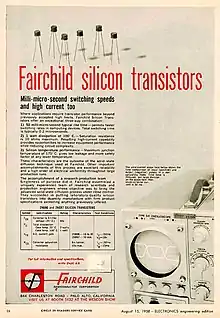

The 2N696 and 2N697 were the first silicon transistors manufactured in Silicon Valley, in 1958, by Fairchild Semiconductor. Fairchild introduced itself to the world via its advertisements for these transistors,[1] which were identical except for a post-manufacturing binning on current gain.[2][3]
The 2N696/2N697 NPN mesa transistor was developed by a team led by Gordon Moore.[4] The first batch of 100 was sold to IBM for $150 each (equivalent to $1,521 in 2022) in order to build the computer for the B-70 bomber. More transistors were sold to Autonetics to build the guidance system for the Minuteman ballistic missile.
The 2N696 and 2N697 were popular devices, quickly copied by several other semiconductor companies, including Texas Instruments,[5] Rheem Semiconductor,[6] and others including Hoffman Electronics Corp. and Industro Transistor Corp.[7] In a 1960 advertisement, Fairchild bragged, "The Fairchild 2N696 and 2N697 are the world's most copied transistors. We have now copied them ourselves in scaled down versions. The 2N717 and 2N718 are exactly the same as these popular types but packaged in the TO-18 case. They occupy 1/3 the volume of the standard TO-5, making them ideal for high-density equipment designs."[8]
References
- ↑ Christophe Lécuyer and David C. Brock (2010). Makers of the Microchip: A Documentary History of Fairchild Semiconductor. MIT Press. pp. 127–129. ISBN 9780262294324.
The advertisement also promoted Fairchild Semiconductor, presenting a very specific image of the firm. It presented a new and unknown firm, by emphasizing expertise in diffusion, research prowess, and manufacturing capability.
- ↑ Christophe Lécuyer and David C. Brock (2010). Makers of the Microchip: A Documentary History of Fairchild Semiconductor. MIT Press. p. 280. ISBN 9780262294324.
Both transistors were made with the same manufacturing process. They were sorted out from one another during testing.
- ↑ National Symposium on Reliability and Quality Control vol. 8. 1962.
The 2N696-7 series is a high speed, medium power, double-diffused mesa transistor encapsulated in a JEDEC TO-5 package. Parameter limits are the same for the 2N696 and 2N697 except for the range of hFE.
- ↑ "Silicon Mesa Transistors Enter Commercial Production". computerhistory.com. Retrieved 2018-09-21.
- ↑ Electronic Design vol. 7. Hayden Publishing Company. 1959. p. 329.
Available now in production quantities...TI 2N696 and TI 2N697 multi-purpose silicon 'mesa' units for amplifier, switching and medium-power applications. Produced by the pioneer of the diffused-base process, these highly-reliable 'mesa' units feature . . . 2-w maximum power dissipation . . . beta spreads of 20–60 (TI 2N696) and 40–120 (TI 2N697) . . . 10-ohm maximum saturation resistance.
- ↑ Lojek, Bo (2007). History of Semiconductor Engineering. Springer. p. 116. ISBN 9783540342588.
Baldwin's business plan was based on an assumption that Rheem could produce a better mesa silicon transistor and be the first on the market with an epitaxial device. Rheem produced a better 2N697 device; the problem was that Lippincott, Ralls and Hendricson, Fairchild's legal counsel, filled suit against Rheem. The court marshals raided Rheem premises and found the Fairchild's proprietary material which Ed and his group took from Fairchild.
- ↑ Solid State Technology vol. 3. Cowan Publishing Corporation. 1960.
- ↑ Several electronics-industry magazines carried the Fairchild ad "New Numbers – Same Popular Transistors" in 1960, including: Electronics vol. 33, McGraw-Hill Publishing Company; Semiconductor Products vol. 3, Cowan Publishing Corporation; Electronic Design vol. 8, Hayden Publishing Company.
External links
- The Transistor Museum – photo of an original Fairchild 2N697